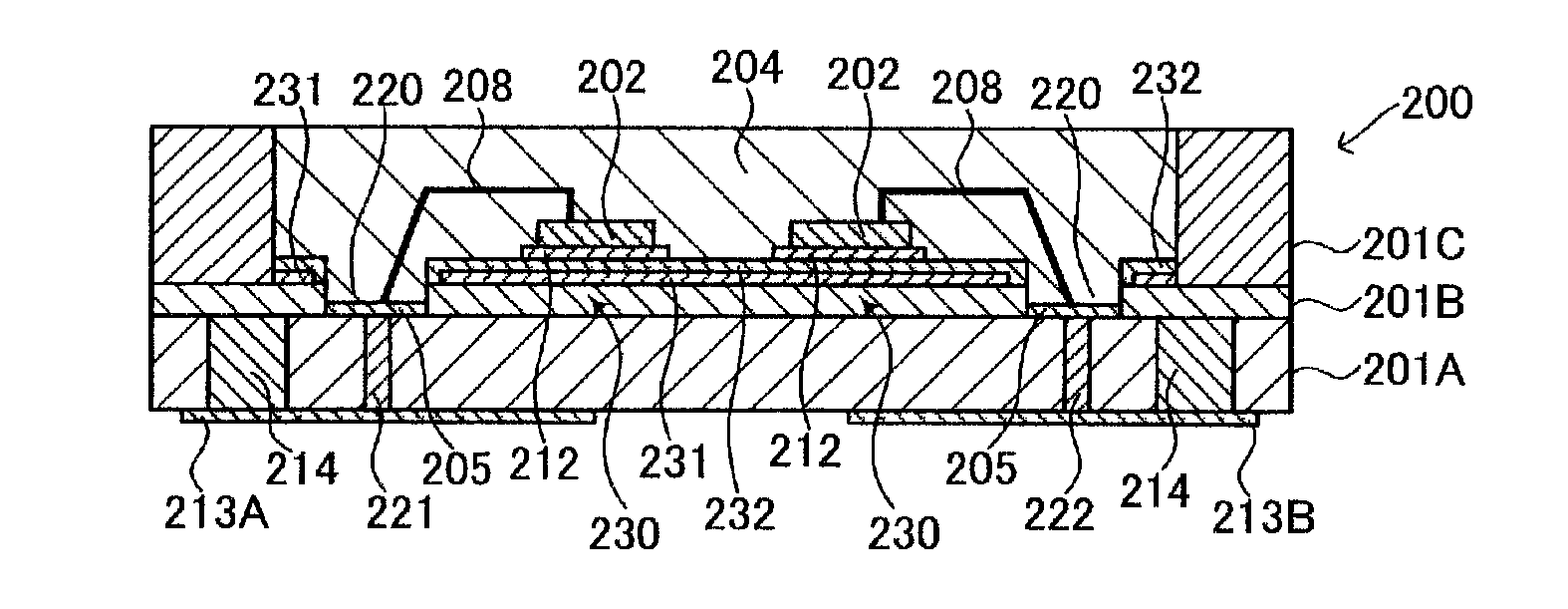Semiconductor light emitting device having heat dissipating vias
a technology of semiconductor light emitting device and heat dissipation via, which is applied in the direction of semiconductor devices, solid-state devices, lighting and heating apparatus, etc., can solve the problems of inability to provide desired intensity or chromaticity, disadvantageous die-bonding strength of leds, and variation of optical axes of leds from one to the other, so as to reduce the degree of influence of irregularities on the element mounting surface, improve heat dissipation performance of semiconductor light emi
- Summary
- Abstract
- Description
- Claims
- Application Information
AI Technical Summary
Benefits of technology
Problems solved by technology
Method used
Image
Examples
first embodiment
[0035]The structure of a semiconductor light emitting device according to a first embodiment of the invention will first be described with reference to FIGS. 1A to 1C and 2A to 2D. FIG. 1A is a perspective view of the semiconductor light emitting device according to the first embodiment of the invention. FIG. 1B is a plan view of the semiconductor light emitting device. FIG. 1C is a bottom view of the semiconductor light emitting device. FIG. 2A is a schematic plan view showing the positions of heat dissipation vias in the semiconductor light emitting device according to the first embodiment. FIG. 2B is a cross-sectional view taken along the line 2B-2B in FIG. 2A. FIG. 2C is a cross-sectional view taken along the line 2C-2C in FIG. 2A. FIG. 2D is an equivalent circuit diagram of the semiconductor light emitting device according to the first embodiment.
[0036]A semiconductor light emitting device 10 includes a wiring substrate 11 having a substantially rectangular shape in the plan vi...
second embodiment
[0058]In the first embodiment, the wiring pads 15 are formed on the second ceramic layer 11B. Alternatively, the wiring pads 15 may be formed on the first ceramic layer 11A. The positions where the wiring pads 15 are formed are thus changed in a second embodiment, which will be described with reference to FIGS. 5A to 5C. The same portions as those in the first embodiment have the same reference numerals, and only the portions different from those in the first embodiment will be described.
[0059]FIG. 5A is a plan view of a semiconductor light emitting device 100 according to the second embodiment of the invention. FIG. 5B is a cross-sectional view taken along the line 5B-5B in FIG. 5A. FIG. 5C is a cross-sectional view taken along the line 5C-5C in FIG. 5A.
[0060]A through hole 101 is formed through the second ceramic layer 11B, as shown in FIGS. 5A to 5C. The wiring pads 15 are formed on the first ceramic layer 11A exposed through the through hole 101. Employing the configuration desc...
third embodiment
[0062]The first and second embodiments have been described with reference to a semiconductor light emitting device having a single LED mounted therein. Alternatively, a plurality of LEDs may be mounted on the wiring substrate. A multichip-type semiconductor light emitting device in which a plurality of LEDs are mounted on the wiring substrate will be described below.
[0063]The structure of a semiconductor light emitting device according to a third embodiment will first be described with reference to FIGS. 6 to 9. FIG. 6A is a perspective view of the semiconductor light emitting device according to the third embodiment. FIG. 6B is a plan view of the semiconductor light emitting device. FIG. 7A is a bottom view of the semiconductor light emitting device. FIG. 7B is a schematic plan view for illustrating the positions of heat dissipation vias in the semiconductor light emitting device according to the third embodiment. FIG. 8A is a cross-sectional view taken along the line 8A-8A in FIG....
PUM
| Property | Measurement | Unit |
|---|---|---|
| thickness | aaaaa | aaaaa |
| size | aaaaa | aaaaa |
| thickness | aaaaa | aaaaa |
Abstract
Description
Claims
Application Information
 Login to View More
Login to View More - R&D
- Intellectual Property
- Life Sciences
- Materials
- Tech Scout
- Unparalleled Data Quality
- Higher Quality Content
- 60% Fewer Hallucinations
Browse by: Latest US Patents, China's latest patents, Technical Efficacy Thesaurus, Application Domain, Technology Topic, Popular Technical Reports.
© 2025 PatSnap. All rights reserved.Legal|Privacy policy|Modern Slavery Act Transparency Statement|Sitemap|About US| Contact US: help@patsnap.com



